Menu
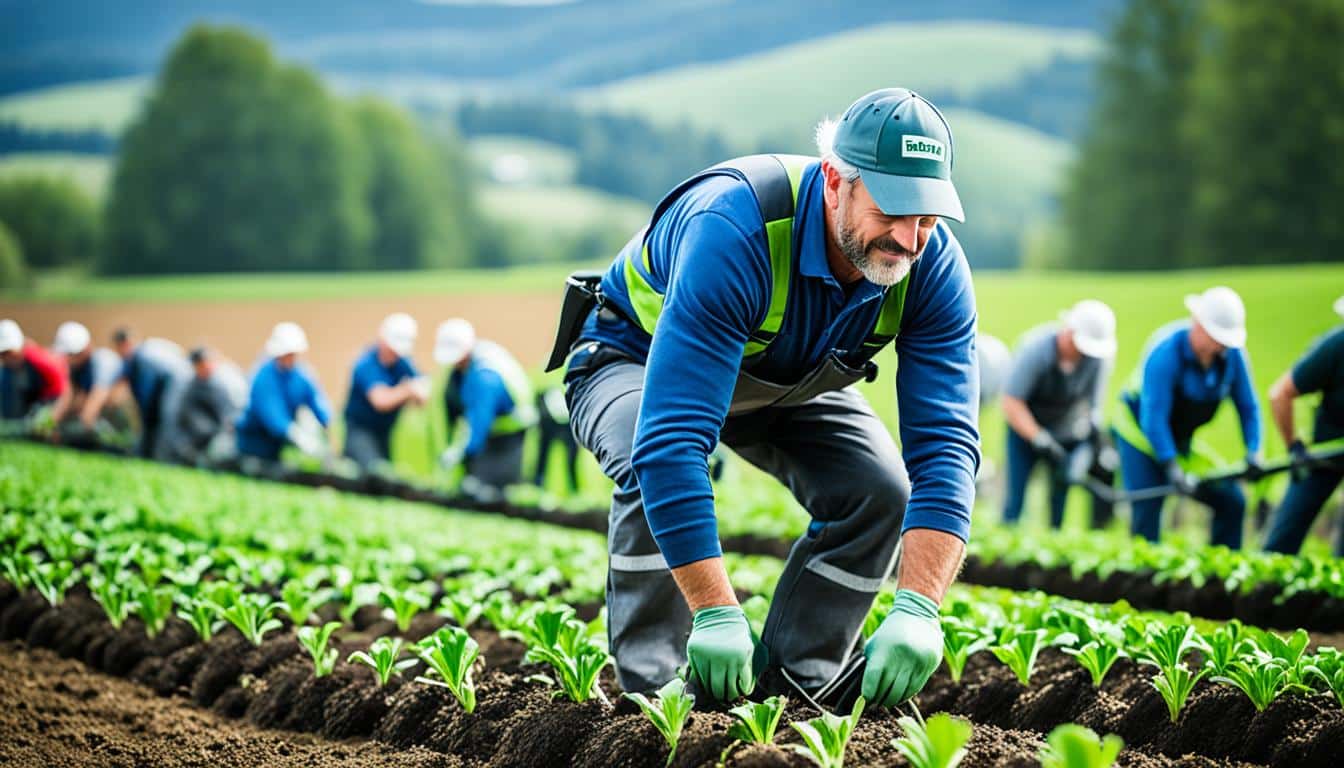
Did you know that work-related musculoskeletal disorders (WMSDs) top the list of work disabilities? In California alone, costs for over 3,000 back injuries could go past $22 million yearly. This makes preventing musculoskeletal disorders on farms crucial. Ergonomics helps by tailoring tasks to people and redesigning tools to cut down muscle fatigue.
Identifying key risks like repetitive motions and awkward postures is vital. Addressing these can greatly lower the number of musculoskeletal issues. Since sprains, strains, and back injuries are common causes of missed work, improving ergonomics is key. It doesn’t just prevent injuries but also improves how much work gets done and keeps workers happy.
Work-related musculoskeletal disorders (MSDs) are a big problem in many jobs, especially farming. These issues include several health conditions. They affect the body’s muscles, bones, and joints, making work hard for those suffering.
MSDs are problems with muscles, nerves, and bones, often linked to work. The FARM study looked at these issues. It focused on 1013 farmers, showing how common and serious MSDs are.
In farming, MSDs like back pain, carpal tunnel syndrome, and tendinitis are common. A large part of the study group, 91.3%, had pain in many areas. Back pain topped the list. It usually comes from doing the same tasks over and over, like lifting heavy items.
Here’s a quick look at common MSDs:
MSDs make it hard to work well. The FARM study showed they cause a lot of pain and stop people from working properly. More than half of farm workers have been in the job for over 30 years, making the issue worse over time.
These points show how bad MSDs can get:
Dealing with MSDs matters a lot in hard-working fields like farming. If we focus on stopping them and improve how people work, we can make a big difference. This approach helps both the health and work of those in agriculture.
Ergonomics is vital in agriculture for keeping farm workers healthy. It focuses on making the tasks easier on the body to lower injury risks and work better. A survey in 1988 found that people in farming often get hurt doing their jobs, especially their muscles and bones.

Ergonomics helps reduce on-the-job injuries and health issues. For example, back pain is very common in farming and more frequent here than in other jobs. By using ergonomics, we can lower these risks and keep farm workers healthy.
The money saved from fewer injuries is a big deal. Injuries in farming can cost over $167 million in healthcare. Plus, when workers are healthier, they work better and miss fewer days. This approach is key in fighting the high rates of muscle and bone problems in agriculture.
Many types of farm work can benefit from ergonomics. For example:
In some farming areas, like nurseries and vineyards, muscle and bone injuries are very common. Ergonomics can make a big difference in these places by making changes that fit their work.
Industries like meat packing and vehicle manufacturing also see a lot of muscle strain. However, farming has its unique challenges, making it crucial to focus on better work methods for farmers.
Ergonomics makes farming safer and more productive. It tackles the health risks that come with farm work, leading to better work performance and lower costs from injuries.
Keeping agricultural workers healthy and efficient means preventing MSDs in farming. Ways to do this include finding risk factors, using ergonomic methods, and applying prevention strategies.
Knowing the risks in farming is the first defence. Studies show tasks like weeding and threshing put a big strain on workers’ backs. Weeding was tough for women, while threshing hit men hard. Understanding which jobs are hard on the body helps us focus our efforts to keep workers safe.
Preventing MSDs calls for many steps. Teaching farm workers through videos and books has made a big difference. Knowing how to farm ergonomically can cut down on the chance of getting hurt. Plus, making work areas and tools suit the workers better lessens physical stress.
Success stories back these strategies. Educational tools have cut down MSD cases. A study on teaching ergonomic farming was a hit. Farmers felt better after learning these practices. These cases prove that teaching and improving how we work make a big difference in farm safety.
Putting these prevention strategies for farming MSDs in place makes farms safer and more effective. This benefits both the workers’ health and the farm’s output.
Farm worker health and safety are top priorities. OSHA and other groups set rules to keep farm workers safe from dangers. Following these rules cuts down on injuries and health issues at work.
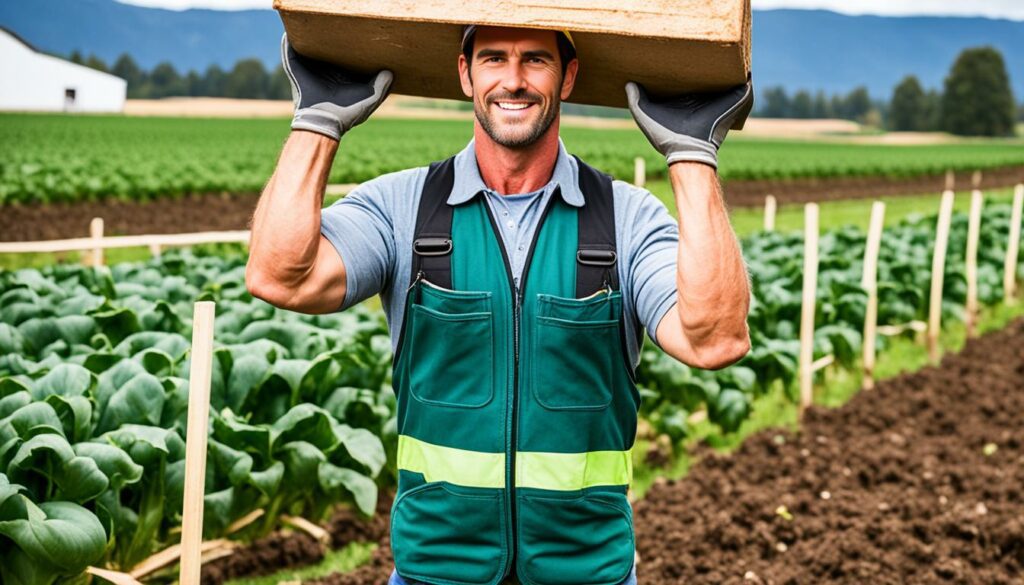
Farming can be very risky. In 2021, 453 people died working on farms. This means there were 19.5 deaths for every 100,000 farm workers. These numbers show the urgent need for strict safety rules. It’s also important to teach people how to use farm machines safely. This can lower the risk of deadly accidents. OSHA’s guidelines are crucial in keeping farm workers safe.
Keeping an eye on farm workers’ health is key to spotting issues early. A study in South Korea found that over 90% of farm workers had muscle pain. Most common was back pain, affecting almost two-thirds of them. This shows that muscle and bone problems are common in farming.
Looking out for farm workers’ health can make farming safer. NIOSH works to improve health and safety on farms through various programs. These efforts aim to keep the farming community healthy and strong.
Using the right ergonomic methods is key in keeping farm workers healthy. It’s all about working in the correct positions and adjusting work setups to lower the risk of muscle and joint problems.
Changing how tools look and where we work can really help. Hard work like gripping hard, kneeling, lifting heavy things, bending, and using vibrating machines can hurt our bodies over time. But, changing how we work can cut down on these dangers.
For example, in California, fixing over 3,000 backs that got hurt cost more than $22 million yearly! This shows how urgently we need to use ergonomic tools and better ways of working to save money and keep farm hands safe.
Teaching the right ways to farm is super important, too. Knowing how to work safely along with using the right tools can stop injuries and makes working more comfortable. A big study showed that 91.3% of the people had muscle or joint pain after work, with back pain being the most common. This proves we really need to focus on good work habits and set-ups.
Also, making work areas fit our bodies better — like by sitting on supportive chairs or using soft knee pads — can do a lot. A third of the injuries in agriculture are from straining our muscles. So, learning the best ways to do our jobs is crucial in keeping us from getting hurt.
| Statistics | Details |
|---|---|
| Musculoskeletal Pain | 91.3% of farm workers reported pain in multiple areas |
| Low Back Pain | 63.8% of subjects reported low back pain |
| Work Absence | 1/3 of injuries were sprains and strains |
| Work Compensation Costs | Over $22 million yearly in California for back injuries |
Taking care of how we work and the tools we use is essential for farm workers’ well-being and good work. It will make our farms run better and keep everyone healthier, which is good for everyone.
It’s crucial to know the dangers in agriculture for worker safety. Recognising these risks helps cut down on injuries and makes work safer.
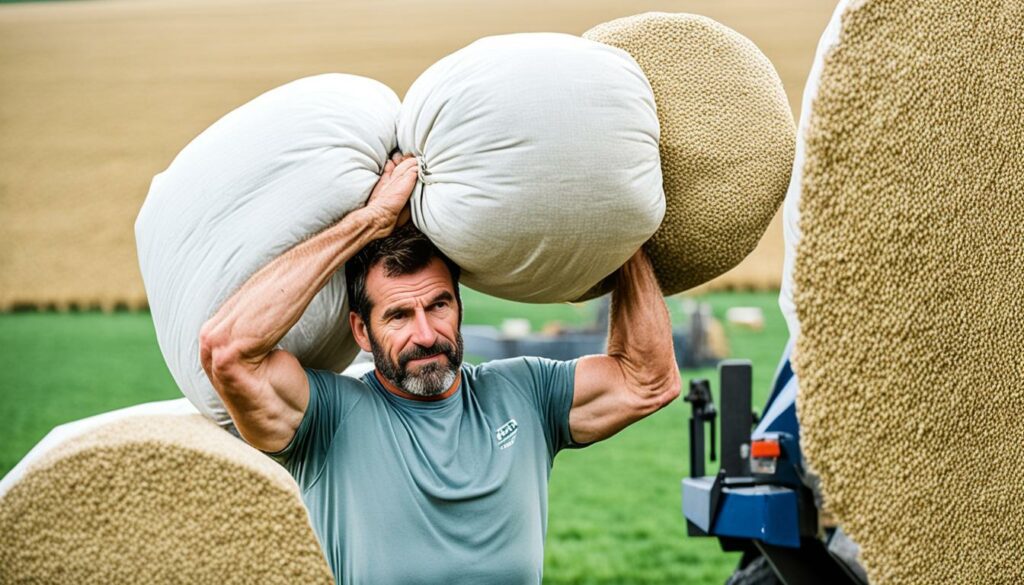
Farming has many risks that can lead to serious health issues. One study found that 91.3% of workers had muscle pain, mostly in their lower back.
Another study showed that 90.6% of farmers had muscle disorders in their lifetime. These can lead to long-term health issues and loss of income.
Crashes on the road with farming equipment are very dangerous. They are more deadly than other work accidents and often involve older farmers.
Over half of people trapped in grain bins die. In 2021, 453 people in agriculture died, showing how risky this work can be.
To lower these risks, farmworkers need to know how to handle things safely. They should also use tools that are better for their bodies and follow strict safety rules.
It’s also key to provide health info and safety training that fits different cultures. This makes it easier for all workers to understand and act on the advice.
Institutions like NIOSH help by focusing on key safety areas for farmers. Their work on pesticide safety, breathing health, muscle problems, and mental well-being is crucial.
Dealing with these dangers in agriculture makes it a better, safer place to work. This improves the lives and jobs of those who help us with farming every day.
Musculoskeletal disorders, known as MSDs, are very common on farms. These injuries affect muscles, tendons, ligaments, and nerves. It is key for farmers to use proper manual handling techniques to avoid such issues. Learning to lift safely and using tools to help are crucial steps.
Lifting things safely in farming is very important. Many lower back injuries happen because of this. Here’s how to do it right:
These tips deal with how often you have to hold things in a tricky way on the farm. They make it less likely you’ll get hurt.
Assistive tools for farming can make things a lot easier. Machines like forklifts, wheelbarrows, and conveyors lift the heavy work off people’s shoulders.
These machines don’t just keep workers safe. They also make jobs quicker and easier. For them to keep working well, they need to be looked after and used correctly.
In summary, using the right manual handling and tools can keep farmers healthy and their work smooth. This makes the farm a safer and more effective place.
Good design in farming tools helps prevent injuries and makes work more effective. This includes making sure the equipment fits the user well. By fitting properly and being well-maintained, tools can lower the effort needed by farmers. They also decrease the chances of farm workers getting hurt.
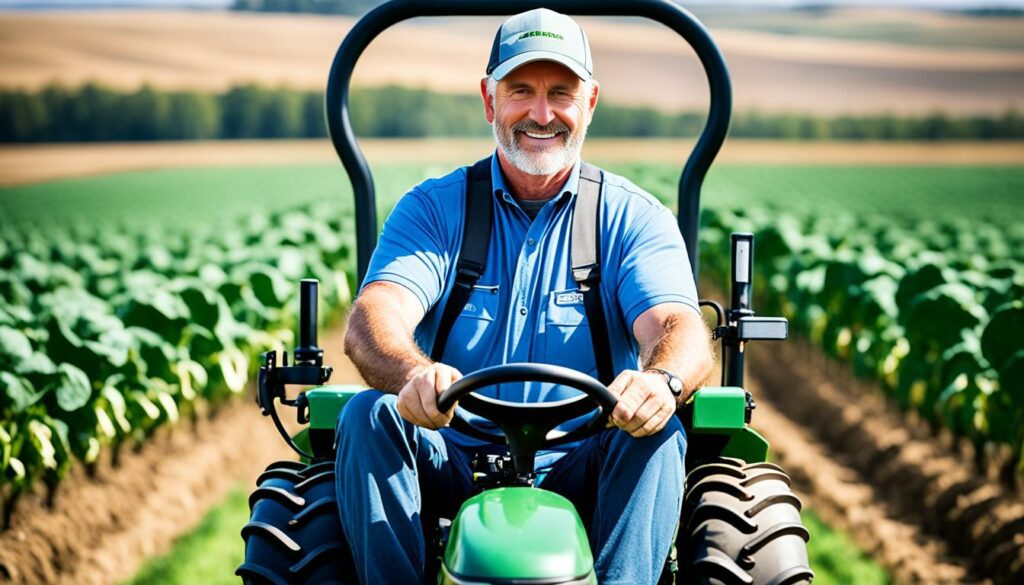
An important part of farming tools is how they’re designed. Ergonomic design focuses on making tools comfortable. This reduces the risk of health problems like musculoskeletal disorders. For example, handles with padding make it easier to hold tools. They help lower the chances of a condition called hand-arm vibration syndrome.
Tools that promote natural body positions can also prevent health issues. These include back pain, shoulder, arm, and hand injuries. Designs that let users adjust tool heights and handles are very helpful.
Keeping agricultural equipment in good condition is key for safety. Regular maintenance stops the machinery from breaking down. This makes sure the tools are easier to use and less likely to cause injuries.
In California, lots of damage happens to farming equipment because of its heavy use. This leads to many back injuries and high compensation costs. Checking and fixing equipment regularly can avoid these problems.
It’s vital to have a set maintenance schedule for tools and machinery. This includes inspecting, servicing, and replacing parts when they are worn. Also, equipment should be calibrated to work like it should. Doing this helps the tools last longer, saving money by avoiding often replacements.
Here is a list of what a good maintenance plan includes:
This plan not only prevents breakdowns but also saves money by avoiding the need for new tools often.
See below a table that shows how MSDs affect different areas and the costs involved.
| Region | Year | Study Focus | Total Injuries | Annual Compensation Costs |
|---|---|---|---|---|
| California, USA | 2003 | Back Injuries | 3,000+ | $22 million |
| Almería, Spain | 2018 | Greenhouse MSDs | Not Specified | Not Specified |
| China | 2014 | Degenerative Lumbar Osteoarthritis | High Prevalence | Not Specified |
By focusing on farming equipment ergonomics, we support the health of farmers and help them work better. Good tool design and maintenance lower the risks of health issues. This makes agriculture a safer and more effective job.
Bringing in ergonomics workplace programmes needs teamwork from everyone. Leaders must champion the cause, and workers must be keen to join in. This is the key to making ergonomic projects work well.
Getting ergonomics workplace programmes to work starts with management commitment. It’s more than just saying you’re for it; managers must actively get involved. They help make sure the workplaces change to meet ergonomic needs. High numbers of back, shoulder, and arm issues in farming show this work is vital. In California farming, the cost of over 3,000 back injuries can top $22 million each year. This points to why investing in ergonomics makes financial sense.
Involving farm workers is just as essential. They see the issues and can suggest needed changes. Teaching workers about ergonomics is critical. Knowing when to adjust, workers can spot signs of fatigue and pain. Rates of health issues like back pain are high, especially in farming. This underlines the urgent need for better ergonomic practices.
Together, strong management commitment and worker involvement can cut down on health issues from work (WMSDs). By working as a team, injuries can be lessened, and a safer work area can be formed.
Starting ergonomics early is key to stop musculoskeletal disorders (MSDs) from getting worse. These issues are a major reason for missed or limited work days. They affect many jobs, from construction and food processing to office work and healthcare.
Being proactive in ergonomics means finding and fixing possible problems before they harm health. Jobs like nursing and firefighting, as well as janitorial and truck driving work, face high MSD risks. This proactive step can cut down the chances of more severe health conditions.
Training on ergonomics helps prevent MSDs by raising awareness and encouraging early reporting of symptoms. This proactive approach can significantly reduce the risk of developing serious conditions.

To manage MSD symptoms effectively, workers need to be taught to spot early signs, like backaches or arm pain. This is very important for farm workers, who have a high MSD risk. In fact, muscle injuries are the main reason for missed work in farming.
| Occupations | MSD Risk Level |
|---|---|
| Registered Nurses | High |
| Nursing Assistants | High |
| Psychiatric Aides | High |
| Firefighters | High |
| Laborers | High |
| Janitors | High |
| Truck Drivers | High |
| Production Workers | High |
| Stock Clerks | Elevated |
| Cleaners/Maids | Elevated |
| Delivery Drivers | Elevated |
| Bus Drivers | Elevated |
| Police Officers | Elevated |
| Mechanics | Elevated |
| Plumbers | Elevated |
| Maintenance Workers | Elevated |
Including workers in checking their work settings and finding solutions can avoid MSDs. By letting workers help spot and fix issues, solutions are more likely to work. Plus, it keeps getting better at reducing MSD risks. Proactive ergonomics can really lower the chances of work causing health issues.
In farming, many successful ergonomic interventions have helped cut down on musculoskeletal disorders. Farm workers often report backaches, plus pain in the shoulders, arms, and hands. These issues cause a lot of missed work, with sprains and strains accounting for a third of the injuries, and back injuries a quarter.
A study showed that using pneumatically-powered cutters for grape picking reduced overuse injuries. By making tubs used for crops smaller in California, there were fewer back injuries. This saved over $22 million in worker’s compensation. It proves that focusing on agricultural ergonomics can make workers healthier and more efficient.
In vineyards, tasks involving repeated lifting and bending were improved. They redesigned jobs to lessen stress on the body. This cut down on the risk of back injuries and made knee and hip problems less common. Ergonomic changes and teaching workers safe methods played a big role.
Thanks to ergonomic-focused redesigns and procedural changes, farming has seen great gains. The following table compares the effects of such ergonomic work on different farming tasks:
| Ergonomic Intervention | Case Studies MSD Prevention | Outcome |
|---|---|---|
| Smaller harvesting tubs | Reduced back injuries | Lower compensation costs |
| Pneumatically-powered cutters | Lowered overuse injuries | Increased productivity |
| Redesigned work processes in vineyards | Decreased back pain | Improved worker wellbeing |
| Ergonomic training implementation | Prevention of knee and hip OA | Enhanced safe practices |
These case studies MSD prevention efforts show the power of systematic ergonomic changes. By continuing to improve agricultural ergonomics, the farming sector can make a big leap in worker health and safety.
It’s key to follow safety rules in farming to avoid muscle and bone injuries. Bringing ergonomic methods into farming is very important. Doing so makes jobs safer and helps workers do more.
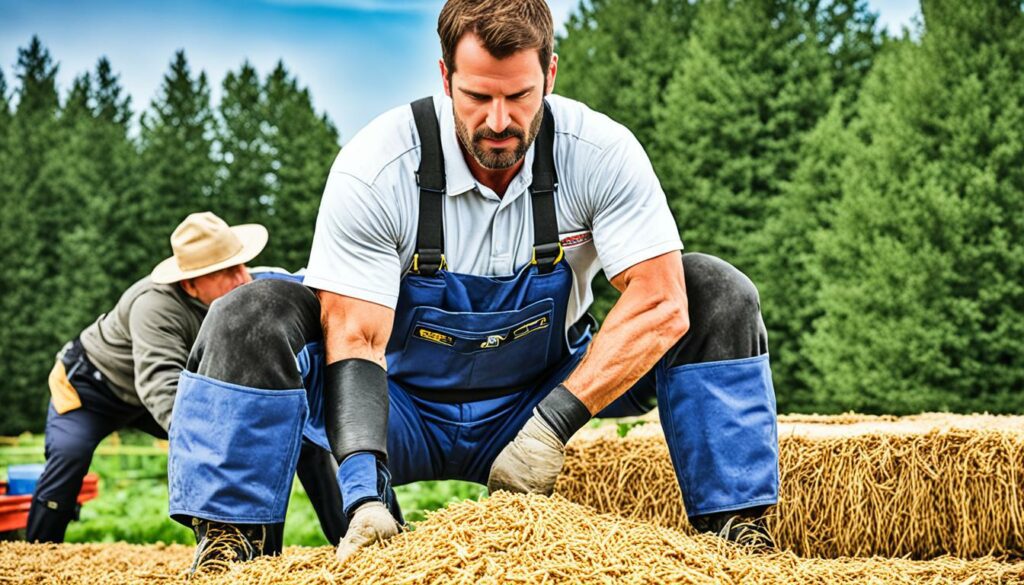
The OSHA gives detailed advice to make farm work safer. Their rules aim to cut down on injuries, especially muscle and bone problems. Many industries, including construction, food making, and firefighting, find these rules helpful.
The National Institute for Occupational Safety and Health (NIOSH) shares smart ways to prevent injuries with farm tools. Their “Guide to Non-Powered Hand Tools” and “Guidelines for Lifting and Carrying by Hand” are full of good tips to keep workers safe. NIOSH also looks into specific issues, like hand injuries in chicken farming and muscle and bone problems in jobs with lots of lifting. This research helps set up the best ways to keep people from getting hurt.
Here is a table showing a mix of NIOSH and OSHA smart advice:
| Industry | NIOSH Recommendations | OSHA Guidelines |
|---|---|---|
| Poultry Processing | Evaluations of Carpal Tunnel Syndrome | Guidelines for Poultry Processing |
| Nursing | MSD Prevention Strategies | Guidelines for Nursing Homes |
| Food Processing | Manual Material Handling Guidelines | Comprehensive Ergonomic Standards |
It’s important to know and use this advice to meet farming safety rules. This makes work in farming safer and more effective.
Ergonomic principles are key for making farms safer, more efficient, and sustainable. The FARM study looked at over a thousand people in farming. It found that over 90% had muscle pain, mostly in the lower back.
Many of those surveyed had spent over 30 years in farming. This shows that the longer you farm, the more these problems can grow.
The study showed that nearly all the farmers (94.3%) finished high school or less. They also usually came from less wealthy families. This means it’s crucial to teach them about ergonomic solutions.
The European Agency for Safety and Health at Work pinpointed the dangers leading to muscle pain. This is common in jobs needing a lot of physical strength. They recommend using tools like NMQ, RULA, OWAS, and REBA to find and stop these risks.
Using ergonomics, proper equipment care, and a focus on health and safety can cut down on muscle problems for farm workers. The nature of farm work and the stress it causes require looking at the big picture.
Important indicators like the EuroQol-5D-3L and Visual Analog Scale back this up. They point to significant health issues for these workers. For agriculture to be lasting, everyone involved must make ergonomic strategies a top priority.
MSDs are conditions that affect our muscles, tendons, ligaments, and nerves. They cover problems like carpal tunnel syndrome and lower back injuries.
MSDs can make us take time off work and lower how well we can work. They bring pain and make it hard to move well. It’s especially tough for jobs that need a lot of physical effort, like farming.
Ergonomics in farming boosts workers by lowering the chance of getting hurt. It makes lifting and bending easier, helping work go faster and causing fewer MSDs.
Stop them by spotting what could cause them, telling someone if you feel unwell early, and fixing how things are done and the tools used.
Always follow safety rules from places like OSHA to keep workers safe. Doing health checks often helps find MSD problems early, leading to quick fixes.
Make workplaces fit better, use the right moves to lower MSD risks, and teach workers the best ways to do their jobs.
Issues like not lifting the right way, not using equipment well, and injuries from doing the same thing over and over are key dangers. Knowing and how to avoid these risks is vital.
Knowing how to lift correctly and using tools to help are great ways to cut down on MSD cases. Training farmers about these can make a big difference.
It’s very important. Well-designed tools and machinery help stop injuries and make working on farms safer.
It needs both bosses and workers to work together. Training everyone on why ergonomics matter and proper ways to work builds a safer, healthier place.
Stopping MSDs early is best. Teaching folks about the signs of MSDs and how to act fast helps keep everyone healthy in the long run.
There are lots of success stories showing how making things better has helped. They talk about better health for workers, fewer injuries, and more work getting done in farming.
OSHA and NIOSH have lots of info on how to stop MSDs. They talk about safe ways to handle things, design tools better, and adjust work spaces. This all makes farming safer and healthier.